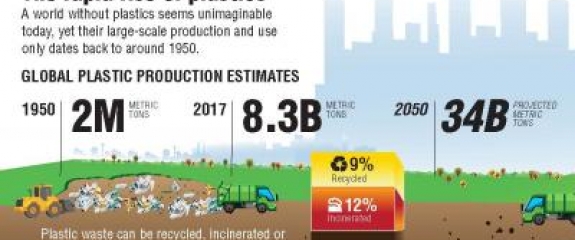Production, use and fate of all plastics ever made

We are facing an environmental disaster, another environmental disaster. A recent attempt to quanity the sheer amount of plastics we are creating has come up with some horrifying statistics and predictions. The study, lead by a University of California-Santa Barbara researcher and published Science Advances, used industrial data on the raw inputs of plastic production from multiple countries. Their period of study covers 1950 to 2015 and estimates put the total at around 9.1 billion tons. The study also makes some concerning predictions. Based on current projections the report suggests that by 2050 we’ll have churned out almost 38 billion tons of plastic and we will have thrown 13 billion tons of it away.
Plastics have become indispensible - try imagining a world where your toothbrushes, dashboards, pens, video game controllers and other paraphenalia of your day-to-day life were made from wood or metal. It seems that our appetitie for cheap gadgets made from dureable plastics knows no end. So where does this plastic end up once we have finished with it?
It is hard to grasp such a huge number, how can we contextualise it? One way of looking at it might be to imagine it as 25,000 Empire State Buildings, 80 million whales or a billion elephants (by weight). Giving it a more current flavour, this would be more than seven quadrillion Lego blocks. Estimates suggest that most of the plastic was either high-density polyethylene (used for plastic bottles and pipes), polypropylene (used for packaging, but has many other applications) or polyvinylchloride (PVC — used for piping). Forty-two percent of the total was used in packaging.
Sadly, very little of the material has beeb recycled (only 9% in the US). Some was burned, but almost 80 percent ended up being discarded, mostly into landfills. About 2.8 billion tons, or about 30 percent of the total, is in use right now, but you can be sure it wont be in use for long. Most plastic products are discarded after less than a few years. However, once discarded they still stick around, they are difficult to properly dispose of. Most plastics simply degrade into smaller and smaller pieces. Out of sight is out of mind but the issue of plastics is becoming an problem. They say that all roads lead to Rome but for plastics the destination is the worlds oceans where tiny plastic particles — called nurdles — are building up. And the problem is making its way back home as the plastic pellets work their way up the food chain leaching toxins.
There are some ways to mitigate the impending crisis, such as recycling and the use of biodegradable plastics. To be effective, however, recycling must forestall new plastic production, not merely add to the total amount of plastic produced, all of which will eventually be thrown out. Plastics will likely be a part of our lives for a long time to come. Take note.


